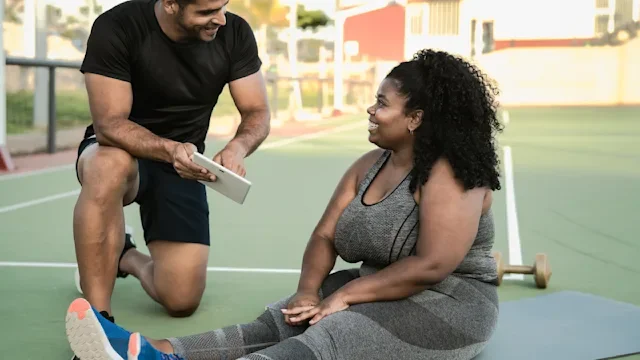Key takeaways:
Cycling is a low-impact workout that can improve your heart health and help you build muscle.
While there are some differences between the two, indoor and outdoor cycling are both beneficial for your health.
You can enjoy the many benefits of cycling at any fitness level.
Whether you like to ride your bike along a local path or take spin classes, cycling is a great aerobic workout. The low-impact exercise provides numerous health benefits for your body and mind. And you can enjoy them at any fitness level. Keep reading to learn more about the benefits of cycling.
8 Benefits of Cycling
Cycling is a versatile activity. You can use it as a mode of transportation, do it for sport, or try it for fun. There are plenty of research-backed reasons to add cycling to your fitness routine.
1. Cycling improves cardiovascular fitness
Cycling can boost your cardiovascular health in more ways than one. For example, one review found that indoor cycling, when combined with diet changes, improves aerobic fitness and blood pressure. Aerobic capacity refers to how easily your heart and lungs transport oxygen during physical activity. So cycling can strengthen your heart and lungs and help you build endurance.
Search and compare options
2. Cycling reduces the risk of chronic diseases
Those heart-healthy benefits may help explain why cycling improves markers of health. One study found that biking to work may reduce your risk of cancer and heart disease.
3. Cycling increases muscular strength
Cycling is an excellent way to build muscle mass and strength in your lower body, especially your quads and hamstrings. It also activates your glutes, calves, and core. This advantage may come as no surprise, given how hard you peddle while biking. For an even more challenging workout, you can increase the resistance on your exercise bike. Or you can ride in a lower gear (higher resistance) while biking outside.
4. Cycling is good for your joints
Unlike high-impact activities, such as running or sprinting, cycling is easy on the joints. The low-impact exercise doesn't put as much stress on weight-bearing joints like your knees and hips. That makes cycling a better option for people with chronic or acute joint pain from illness or injury. Evidence suggests that stationary cycling may even reduce knee pain in people with osteoarthritis.
Cycling is also a great way to supplement your training if you run or play high-impact sports. You can ease stress on your joints while still getting a workout.
5. Cycling enhances balance and coordination
Cycling requires balance and coordination. And research suggests that it may enhance those skills. One study showed that stationary cycling improved balance and gait in people who had strokes.
Exercise bike workouts can also increase leg strength, lower limb function, and balance in older adults. Falls are a leading cause of injury among adults 65 or older. So improving your balance, coordination, and strength through cycling may reduce your risk of falls.
Read more like this
Explore these related articles, suggested for readers like you.
6. Cycling helps you maintain a healthy weight
Like all forms of exercise, cycling can help you achieve or maintain a healthy weight. Studies show that cycling can be an effective way to lose weight.
If you're looking to increase your calorie burn, you can add high-intensity interval training (HIIT) to your cycling workout. HIIT combines short bursts of high-intensity exercise with brief recovery intervals. Research suggests that HIIT cycling can boost aerobic fitness and lower blood pressure. This type of training increases your metabolic rate, which means you'll continue to burn calories after you're done exercising.
7. Cycling improves mental health
If you’ve ever felt a mood boost after a good workout, there’s a reason. Regular exercise has been shown to reduce stress, anxiety, and depression. And cycling is no exception. For example, a study found that people who biked to work four or five days per week had a lower risk of stress than those who biked fewer than four days per week.
8. Cycling improves cognition
Exercise may improve your cognition. Cycling has been shown to help with executive function and processing speed in older adults. In other words, as your body gets fit, so does your mind.
What's the difference between stationary cycling and outdoor cycling?
Stationary cycling and outdoor cycling require similar pedaling strokes but offer different experiences. The former takes place on an exercise bike, like a recumbent bike or an indoor cycle (often called a spin bike). Like a traditional outdoor bicycle, exercise bikes have pedals and a seat. But they usually only have one wheel, which often isn't visible.
That means you don't have to balance the bike. So it can be a safer option for older adults or people with mobility or balance issues. Like treadmills, most exercise bikes include features that allow you to adjust the intensity of your workout. You can customize your ride based on your goals and abilities.
But riding a bike outside allows you to breathe fresh air, feel the sunshine on your skin, and unplug from screens for a bit. Plus, research suggests that exercising outside can boost your mental and physical health and motivate you to stay active.
However, with outdoor cycling, you have to balance the bike and watch for obstacles on your path. Depending on where you bike, you may encounter other cyclists, drivers, and more on your ride. So outdoor cycling is a less beginner-friendly option.
How often should I cycle?
Generally, adults should aim for 150 minutes of moderate-intensity aerobic exercise or 75 minutes of vigorous-intensity exercise every week. You should combine this with strength-training activities at least twice a week, per the CDC.
These guidelines are designed to help you maintain optimal health and reduce the risk of chronic illnesses. And cycling is a great way to get an aerobic workout.
If you are new to cycling, you can start slowly. And remember, some exercise is better than none. Even 10 minutes of cycling can help improve your health. Doing too much too soon can increase your risk of injury and leave you feeling sore or unmotivated. So work your way up to specific fitness goals, and celebrate every win along the way.
The bottom line
Whether you ride your bike outside or take on an indoor exercise workout, cycling can improve your physical and mental health. Remember to wear your helmet if you ride outside, and consult your healthcare provider before beginning a new exercise routine.

Why trust our experts?



References
Avila-Palencia, I., et al. (2017). The relationship between bicycle commuting and perceived stress: A cross-sectional study. BMJ Open.
Aylett, E., et al. (2018). Exercise in the treatment of clinical anxiety in general practice – a systematic review and meta-analysis. BMC Health Services Research.
Barnes, J. N. (2015). Exercise, cognitive function, and aging. Advances in Physiology Education.
Bianco, A., et al. (2010). The effects of indoor cycling training in sedentary overweight women. Journal of Sports Medicine and Physical Fitness.
Celis-Morales, C. A., et al. (2017). Association between active commuting and incident cardiovascular disease, cancer, and mortality: Prospective cohort study. BMJ.
Centers for Disease Control and Prevention. (2020). Keep on your feet—preventing older adult falls.
Centers for Disease Control and Prevention. (2022). How much physical activity do adults need?.
Chavarrias, M., et al. (2019). Health benefits of indoor cycling: A systematic review. Medicina.
Coon, J. T., et al. (2011). Does participating in physical activity in outdoor natural environments have a greater effect on physical and mental wellbeing than physical activity indoors? A systematic review. Environmental Science & Technology.
Dumain, T. (2019). Cycling and arthritis: Why is cycling good for your joints, and how to get started. CreakyJoints.
Gladwell, V. F., et al. (2013). The great outdoors: How a green exercise environment can benefit all. Extreme Physiology & Medicine.
Gujral, S., et al. (2017). Exercise effects on depression: Possible neural mechanisms. General Hospital Psychiatry.
Jung, W. S., et al. (2019). Comparison of excess post-exercise oxygen consumption of different exercises in normal weight obesity women. Journal of Exercise Nutrition & Biochemistry.
Kim, S. J., et al. (2015). Effects of stationary cycling exercise on the balance and gait abilities of chronic stroke patients. Journal of Physical Therapy Science.
Leyland, L. A., et al. (2019). The effect of cycling on cognitive function and well-being in older adults. PLoS One.
Luan, L., et al. (2021). Stationary cycling exercise for knee osteoarthritis: A systematic review and meta-analysis. Clinical Rehabilitation.
Oja, P., et al. (2011). Health benefits of cycling: A systematic review. Scandinavian Journal of Medicine & Science in Sports.
Ozaki, H., et al. (2015). Cycle training induces muscle hypertrophy and strength gain: Strategies and mechanisms. Acta Physiologica Hungarica.
Rissel, C., et al. (2013). Two pilot studies of the effect of bicycling on balance and leg strength among older adults. Journal of Environmental and Public Health.
UC Davis Health. (n.d.). VO2: Rate of oxygen consumption.
Vollaard, N. B. J., et al. (2017). Research into the health benefits of sprint interval training should focus on protocols with fewer and shorter sprints. Sports Medicine.















